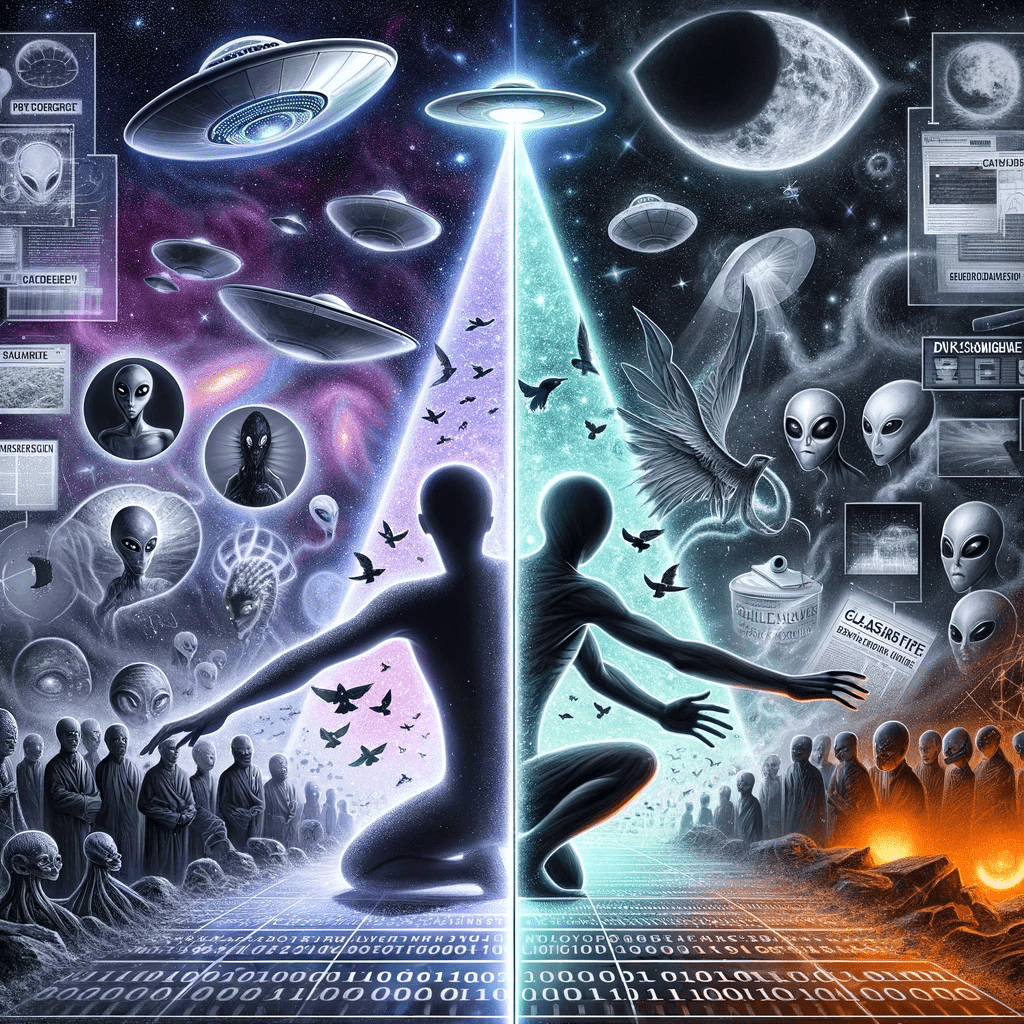UAP, Alien Beings and the Oxymoron of Secrecy vs. Disclosure

In the context of the existence of Unidentified Aerial Phenomena (UAP) and NHI entities, the debate surrounding secrecy and disclosure presents a fascinating study in contrasts. The irony lies in the very nature of the two seemingly opposing forces: one advocating for concealment and the other for revelation. When scrutinized scientifically and sociologically, the dichotomy might very well appear as a paradoxical conjunction, making “secrecy vs. disclosure” an oxymoronic phrase.
1. The Quantum Analogy:
To understand this oxymoron, consider the quantum realm’s superposition principle, where particles exist in multiple states until observed. In a sense, UAPs and alien existence could be likened to the quantum world – existing in a state of both ‘known’ and ‘unknown’ simultaneously. Until information is definitively disclosed, and as long as secrecy is maintained, these phenomena dwell in a superposition of reality and speculation.
2. Secrecy Fuels Speculation:
The more governmental or institutional bodies attempt to keep UAPs and potential alien interactions concealed, the more speculation, conspiracy theories, and public intrigue grows. The very act of secrecy becomes a catalyst for discussion and a thirst for knowledge. Paradoxically, by trying to suppress information, the desire for disclosure is intensified. Each redacted document or whistleblower testimony only reinforces public interest, rendering secrecy as an unintentional promoter of disclosure.
3. The Sociological Implications of Disclosure:
Full disclosure might not yield the clarity that society seeks. Imagine a scenario where the existence of multiple NHI species is confirmed. Despite this confirmation, the vastness of the universe and the potential myriad of civilizations within it would mean that our understanding would still be infinitesimally small. Each disclosure leads to a plethora of new questions, making it an endless loop of partial knowledge. Thus, even in disclosure, there exists an inherent secrecy—the unknown parameters and characteristics of the infinite cosmos.
4. The Dynamics of Knowledge:
The binary concept of “known” and “unknown” becomes complex when alien phenomena are introduced. The realm of the “unknown” is expansive, and the moment a piece of information shifts from the “unknown” to the “known”, it opens up a myriad of new “unknowns”. Hence, even as disclosure attempts to shift knowledge from darkness to light, it inevitably reveals more shadows. This dynamic interplay is a testament to the ever-evolving frontier of knowledge.
5. Evolutionary and Psychological Factors:
From an evolutionary standpoint, humans are wired to recognize patterns and fear the unknown. Secrecy plays on this inherent fear, acting as a protective mechanism. In contrast, disclosure provides relief by unveiling the unknown. However, this dualistic relationship becomes oxymoronic when one considers that the very nature of disclosure in the context of UAPs and alien beings could introduce more complexities and unknowns, leading to increased anxiety and uncertainty.
6. The Paradox:
For scientific communities, credibility is paramount. Many professionals shy away from discussing UAPs or extraterrestrial life for fear of undermining their professional standing. However, this veil of silence can be perceived as an acknowledgment of the phenomena’s gravity. Thus, the very act of avoiding disclosure in pursuit of credibility can inadvertently lend more weight to the subject’s validity.
Physical hardware and NHI presence are undeniable. Whether one refers to them as Unidentified Aerial Phenomena (UAP), UFOs, extraterrestrial entities, interdimensional beings, or non-human intelligence, it’s ultimately a matter of nomenclature.
The interplay between secrecy and disclosure in the context of UAPs and extraterrestrial lifeforms is rich in contradictions. It challenges our perceptions of knowledge, the nature of reality, and our evolutionary inclinations. Much like the Yin and Yang of ancient philosophy, secrecy and disclosure exist in a harmonious dance of opposition, each defining the other and, paradoxically, each containing elements of the other. This duality is reminiscent of age-old contrasts such as good vs. evil, angels vs. demons, and God vs. Lucifer.
In the universe’s vast expanse, when opposing forces like secrecy and disclosure clash over the phenomena, neither may fully triumph. The real victor is humanity’s unending quest for knowledge. The battles between good and evil or angels and demons show that it’s not about a definitive outcome but the ongoing process and lessons derived. With every revelation in any field, new questions emerge, pushing the boundaries of understanding. The essence of this cosmic contest is the perpetual search, fueled by both the urge to reveal and the need to conceal.
The oxymoronic relationship between the two serves as a reminder that, in the vastness of the cosmos, binary concepts might be inadequate in capturing the profound complexities of the universe.

